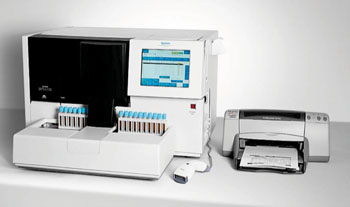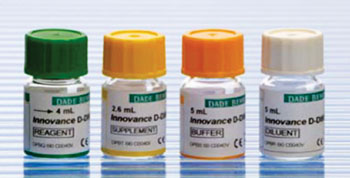D-Dimer Efficacy Evaluated for Disseminated Intravascular Coagulation Diagnosis
|
By LabMedica International staff writers Posted on 17 Feb 2016 |

Image: Sysmex C-1500 automatic coagulation analyzer (Photo courtesy of Siemens Healthcare).

Image: The Innovance D-Dimer reagent set (Photo courtesy of Siemens Healthcare).
Disseminated intravascular coagulation refers to an acquired syndrome characterized by procoagulant substances entering the general circulation and leading to a systemic thrombotic process, which may be derived from or causing microvascular system damage.
D-dimer (D-D) was shown to be an important indicator for the diagnosis of overt disseminated intravascular coagulation (DIC) and non-overt DIC; however, its diagnostic cutoff value in the clinic is not clearly defined. The initiation of treatment in nonovert DIC leads to better outcome than in DIC and therefore, early diagnosis of non-overt DIC is pivotal for DIC prevention and treatment.
Clinical scientists at the Nanjing Medical University (Suzhou, China) enrolled 40 male and 80 female cases in each group (DIC, non-overt DIC, and non-DIC control group). All 360 cases were collected in Suzhou Municipal Hospital. The DIC group included patients clearly diagnosed with DIC who had been hospitalized in the intensive care unit (ICU); the non-overt DIC group comprised patients who were diagnosed later as DIC; and the non-DIC control group included patients who were convalescing after surgery, had normal liver and kidney function.
D-D, fibrinogen degradation products (FDP), prothrombin time (PT), activated partial thromboplastin time (APTT), fibrinogen (Fg), thrombin time (TT), antithrombin (AT), and blood platelet count (PLT) of 360 cases were used to assess the diagnostic efficacy of Innovance D-Dimer reagent (Siemens Healthcare Diagnostics, Erlangen, Germany) for the diagnosis of DIC and non-overt DIC, compared to, or combined with, other DIC coagulation indicators. D-D was quantitatively analyzed using a Sysmex CA1500 automatic coagulation analyzer (Sysmex Corporation; Kobe, Japan) with an immunoturbidimetric method.
The investigators found that when D-D was greater than 3.0 μg/mL was used as the cutoff, the sum of diagnostic sensitivity and specificity reached maximum values for DIC and non-overt DIC, whereas the sum of misdiagnoses and missed diagnosis rate was minimal. Excluding D-D, AT, or Fg, but not TT, from the test combination reduced the diagnostic sensitivity of DIC or non-overt DIC by various degrees. Combining two factors, D-D of greater than 3.0 μg/mL and FDP of greater than 10 mg/L, increased the sensitivity and specificity for the diagnosis of DIC and non-overt DIC.
The authors concluded that monitoring D-D and FDP levels is useful for early intervention and improving microcirculation disturbance caused by disease. They propose that a cutoff value of D-D of greater than 3.0 μg/mL would be suitable for the InnovanceR D-D reagent in the laboratory; D-D in combination with FDP is meaningful for primary screening of non-overt DIC. The study was published on February 2, 2016, in the International Journal of Laboratory Hematology.
Related Links:
Nanjing Medical University
Siemens Healthcare Diagnostics
Sysmex Corporation
D-dimer (D-D) was shown to be an important indicator for the diagnosis of overt disseminated intravascular coagulation (DIC) and non-overt DIC; however, its diagnostic cutoff value in the clinic is not clearly defined. The initiation of treatment in nonovert DIC leads to better outcome than in DIC and therefore, early diagnosis of non-overt DIC is pivotal for DIC prevention and treatment.
Clinical scientists at the Nanjing Medical University (Suzhou, China) enrolled 40 male and 80 female cases in each group (DIC, non-overt DIC, and non-DIC control group). All 360 cases were collected in Suzhou Municipal Hospital. The DIC group included patients clearly diagnosed with DIC who had been hospitalized in the intensive care unit (ICU); the non-overt DIC group comprised patients who were diagnosed later as DIC; and the non-DIC control group included patients who were convalescing after surgery, had normal liver and kidney function.
D-D, fibrinogen degradation products (FDP), prothrombin time (PT), activated partial thromboplastin time (APTT), fibrinogen (Fg), thrombin time (TT), antithrombin (AT), and blood platelet count (PLT) of 360 cases were used to assess the diagnostic efficacy of Innovance D-Dimer reagent (Siemens Healthcare Diagnostics, Erlangen, Germany) for the diagnosis of DIC and non-overt DIC, compared to, or combined with, other DIC coagulation indicators. D-D was quantitatively analyzed using a Sysmex CA1500 automatic coagulation analyzer (Sysmex Corporation; Kobe, Japan) with an immunoturbidimetric method.
The investigators found that when D-D was greater than 3.0 μg/mL was used as the cutoff, the sum of diagnostic sensitivity and specificity reached maximum values for DIC and non-overt DIC, whereas the sum of misdiagnoses and missed diagnosis rate was minimal. Excluding D-D, AT, or Fg, but not TT, from the test combination reduced the diagnostic sensitivity of DIC or non-overt DIC by various degrees. Combining two factors, D-D of greater than 3.0 μg/mL and FDP of greater than 10 mg/L, increased the sensitivity and specificity for the diagnosis of DIC and non-overt DIC.
The authors concluded that monitoring D-D and FDP levels is useful for early intervention and improving microcirculation disturbance caused by disease. They propose that a cutoff value of D-D of greater than 3.0 μg/mL would be suitable for the InnovanceR D-D reagent in the laboratory; D-D in combination with FDP is meaningful for primary screening of non-overt DIC. The study was published on February 2, 2016, in the International Journal of Laboratory Hematology.
Related Links:
Nanjing Medical University
Siemens Healthcare Diagnostics
Sysmex Corporation
Latest Hematology News
- New Scoring System Predicts Risk of Developing Cancer from Common Blood Disorder
- Non-Invasive Prenatal Test for Fetal RhD Status Demonstrates 100% Accuracy
- WBC Count Could Predict Severity of COVID-19 Symptoms
- New Platelet Counting Technology to Help Labs Prevent Diagnosis Errors
- Streamlined Approach to Testing for Heparin-Induced Thrombocytopenia Improves Diagnostic Accuracy
- POC Hemostasis System Could Help Prevent Maternal Deaths
- New Test Assesses Oxygen Delivering Ability of Red Blood Cells by Measuring Their Shape
- Personalized CBC Testing Could Help Diagnose Early-Stage Diseases in Healthy Individuals
- Non-Invasive Test Solution Determines Fetal RhD Status from Maternal Plasma
- First-Of-Its-Kind Smartphone Technology Noninvasively Measures Blood Hemoglobin Levels at POC

- Next Gen CBC and Sepsis Diagnostic System Targets Faster, Earlier, Easier Results
- Newly Discovered Blood Group System to Help Identify and Treat Rare Patients
- Blood Platelet Score Detects Previously Unmeasured Risk of Heart Attack and Stroke
- Automated Benchtop System to Bring Blood Testing To Anyone, Anywhere
- New Hematology Analyzers Deliver Combined ESR and CBC/DIFF Results in 60 Seconds
- Next Generation Instrument Screens for Hemoglobin Disorders in Newborns
Channels
Clinical Chemistry
view channel
Carbon Nanotubes Help Build Highly Accurate Sensors for Continuous Health Monitoring
Current sensors can measure various health indicators, such as blood glucose levels, in the body. However, there is a need to develop more accurate and sensitive sensor materials that can detect lower... Read more
Paper-Based Device Boosts HIV Test Accuracy from Dried Blood Samples
In regions where access to clinics for routine blood tests presents financial and logistical obstacles, HIV patients are increasingly able to collect and send a drop of blood using paper-based devices... Read moreMolecular Diagnostics
view channel
RNA-Based Blood Test Detects Preeclampsia Risk Months Before Symptoms
Preeclampsia remains a major cause of maternal morbidity and mortality, as well as preterm births. Despite current guidelines that aim to identify pregnant women at increased risk of preeclampsia using... Read more
First Of Its Kind Test Uses microRNAs to Predict Toxicity from Cancer Therapy
Many men with early-stage prostate cancer receive stereotactic body radiotherapy (SBRT), a highly precise form of radiation treatment that is completed in just five sessions. Compared to traditional radiation,... Read moreNovel Cell-Based Assay Provides Sensitive and Specific Autoantibody Detection in Demyelination
Anti-myelin-associated glycoprotein (MAG) antibodies serve as markers for an autoimmune demyelinating disorder that affects the peripheral nervous system, leading to sensory impairment. Anti-MAG-IgM antibodies... Read moreImmunology
view channel
Stem Cell Test Predicts Treatment Outcome for Patients with Platinum-Resistant Ovarian Cancer
Epithelial ovarian cancer frequently responds to chemotherapy initially, but eventually, the tumor develops resistance to the therapy, leading to regrowth. This resistance is partially due to the activation... Read more
Machine Learning-Enabled Blood Test Predicts Immunotherapy Response in Lymphoma Patients
Chimeric antigen receptor (CAR) T-cell therapy has emerged as one of the most promising recent developments in the treatment of blood cancers. However, over half of non-Hodgkin lymphoma (NHL) patients... Read moreMicrobiology
view channel
Handheld Device Deliver Low-Cost TB Results in Less Than One Hour
Tuberculosis (TB) remains the deadliest infectious disease globally, affecting an estimated 10 million people annually. In 2021, about 4.2 million TB cases went undiagnosed or unreported, mainly due to... Read more
New AI-Based Method Improves Diagnosis of Drug-Resistant Infections
Drug-resistant infections, particularly those caused by deadly bacteria like tuberculosis and staphylococcus, are rapidly emerging as a global health emergency. These infections are more difficult to treat,... Read more
Breakthrough Diagnostic Technology Identifies Bacterial Infections with Almost 100% Accuracy within Three Hours
Rapid and precise identification of pathogenic microbes in patient samples is essential for the effective treatment of acute infectious diseases, such as sepsis. The fluorescence in situ hybridization... Read morePathology
view channel
Advanced Imaging Reveals Mechanisms Causing Autoimmune Disease
Myasthenia gravis, an autoimmune disease, leads to muscle weakness that can affect a range of muscles, including those needed for basic actions like blinking, smiling, or moving. Researchers have long... Read more
AI Model Effectively Predicts Patient Outcomes in Common Lung Cancer Type
Lung adenocarcinoma, the most common form of non-small cell lung cancer (NSCLC), typically adopts one of six distinct growth patterns, often combining multiple patterns within a single tumor.... Read moreTechnology
view channel
Pain-On-A-Chip Microfluidic Device Determines Types of Chronic Pain from Blood Samples
Chronic pain is a widespread condition that remains difficult to manage, and existing clinical methods for its treatment rely largely on self-reporting, which can be subjective and especially problematic... Read more
Innovative, Label-Free Ratiometric Fluorosensor Enables More Sensitive Viral RNA Detection
Viruses present a major global health risk, as demonstrated by recent pandemics, making early detection and identification essential for preventing new outbreaks. While traditional detection methods are... Read moreIndustry
view channel
Cepheid and Oxford Nanopore Technologies Partner on Advancing Automated Sequencing-Based Solutions
Cepheid (Sunnyvale, CA, USA), a leading molecular diagnostics company, and Oxford Nanopore Technologies (Oxford, UK), the company behind a new generation of sequencing-based molecular analysis technologies,... Read more
Grifols and Tecan’s IBL Collaborate on Advanced Biomarker Panels
Grifols (Barcelona, Spain), one of the world’s leading producers of plasma-derived medicines and innovative diagnostic solutions, is expanding its offer in clinical diagnostics through a strategic partnership... Read more






















